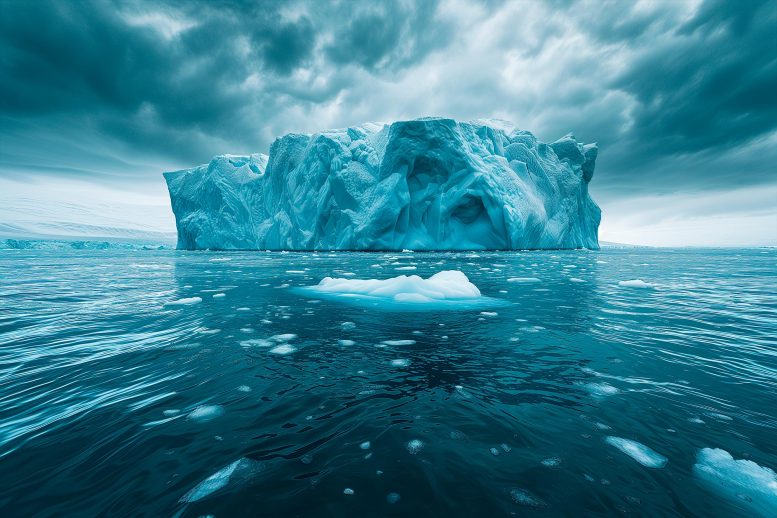
New research conducted by the Mann Research Group reveal that the Mid-Pleistocene Transition’s shift in glacial cycles is influenced by historical climatic events and current environmental factors, offering new insights for potential climate mitigation strategies. Credit: SciTechDaily.com
Scientists from the Mann Research Group drove a climate model both forward and backward in time and discovered significant path dependence in the development of Plio-Pleistocene glaciations.
The climate modeling community has been particularly vexed by the glacial and interglacial cycles over the past three million years, during which the Northern Hemisphere alternated between periods with and without extensive ice sheets.
From about 1.25 million to 750,000 years ago—in the Pleistocene epoch—a change in glacial cycles called the Mid-Pleistocene Transition (MPT) occurred. During this time, glacial/interglacial cycles shifted from occurring every 41,000 years to every 100,000 years, with an increase in the amplitude and asymmetry of the cycles. Scientists are working to understand why these changes happened, considering that insolation forcing—variation in energy that Earth receives from the sun—does not on its own explain the change.
Path Dependence in Glacial Evolution
Now, scientists from the Mann Research Group in the School of Arts & Sciences at the University of Pennsylvania and the Potsdam Institute for Climate Impact Research have found strong path dependence, also known as hysteresis behavior, in the evolution of Plio-Pleistocene glaciations. This means the evolution of glaciations isn’t only a function of factors such as carbon dioxide levels and solar output, but also that it is constrained by previous events.
They show that a gradual decrease in both regolith—sediment that prevents the growth of large ice sheets—and in volcanic outgassing, when eruptions release carbon dioxide into the atmosphere, are required to produce the MPT. Their findings were published on June 17 in Proceedings of the National Academy of Sciences.
“What we have seen in this study is that with the same amount of volcanic outgassing, the model calculates different concentrations of atmospheric CO2. This indicates that the carbon cycle does not behave linearly and depends on its initial state,” says first author Judit Carrillo, a postdoctoral fellow in the Mann Research Group.
Climate scientist Michael E. Mann says these results indicate it’s not too late to act to keep present-day ice sheets from collapsing.
The researchers explain that the model determines where the carbon dioxide that is outgassed by volcanoes goes. This could help scientists better predict the impact of human-caused greenhouse gas emissions, says Carrillo.
Model-Based Research and Findings
This research used the CLIMBER-2 Earth system model of intermediate complexity, which includes atmosphere, ocean, ice sheet, and carbon cycle components. Mann explains that this model allows researchers to do simulations of millions of years, which wouldn’t be possible with the most complex and detailed models. Matteo Willeit of the Potsdam Institute, a co-author on the paper, led a 2019 study using this model to reproduce the main features of the Plio-Pleistocene glacial/interglacial cycles.
In the new study, the researchers built on the 2019 paper by driving the model forward and backward in time over the past three million years, testing different regolith configurations to assess their impact on the MPT. The results suggest that depleted regolith and lowered CO2 levels are required to produce the 100,000-year, sawtooth-shaped cycle, but that carbon dioxide determines the onset of the MPT more fundamentally than the rate of regolith depletion.
“We find that this evolution is path dependent and, to be specific, not reversible in time,” the authors conclude. “In experiments beginning with modern preindustrial conditions and driving the model back in time with time-reversed Earth orbital and tectonic forcing, the warm, relatively ice-free conditions of the late Pliocene and early Pleistocene are not reproduced.”
Mann adds that this finding potentially has broader implications. “The fact that ice sheet extent depends not just on carbon dioxide concentrations by the direction in time, i.e. whether the climate is in a cooling or warming phase, provides a little bit of good news,” he says. “Even though ice sheet extent was greatly diminished, and sea level substantially higher the last time carbon dioxide levels were as high as they are today several million years ago, the collapse of ice sheets is probably not yet locked in. We’ve got a bit of a cushion if we can bring carbon emissions down dramatically and quickly.”
The researchers caution that because the simulations are based on a single model, and because long-term simulations of glacial/interglacial cycles are still in their infancy, their results are not a definitive characterization of climate system behavior but “should be thought of as providing evidence of dynamical behavior that is worthy of further investigation through multiple modeling frameworks.” They note that a worthwhile next step from this work would be extending simulations further back in time, into the Miocene, when carbon dioxide levels were even higher.
Carrillo says the Mann Research Group is currently working to better understand how the carbon cycle works and why hysteresis behavior occurs and is working with a new version of CLIMBER that has higher spatial resolution to better analyze the Greenland ice sheet.
Reference: “Path-dependence of the Plio–Pleistocene glacial/interglacial cycles” by Judit Carrillo, Michael E. Mann, Christopher J. Larson, Shannon Christiansen, Matteo Willeit, Andrey Ganopolski, Xueke Li and Jack G. Murphy, 17 June 2024, Proceedings of the National Academy of Sciences.
DOI: 10.1073/pnas.2322926121
The study was funded by the German Federal Ministry of Education and Research and the University of Pennsylvania School of Arts & Sciences.









“This means the evolution of glaciations isn’t only a function of factors such as carbon dioxide levels and solar output, but also that it is constrained by previous events.”
An alternative working hypothesis is that the assumed cause-and-effect relationship between CO2 and warming is invalid. If a particular assumed driver does not always work as expected, then one is probably observing a spurious correlation.
From the linked article:
“Regolith also modifies the surface albedo when deposited on the ice sheet surface, facilitating melting and further preventing the growth of large ice sheets.”
There are a lot of unexamined assumptions in that statement. The albedo of the regolith will be determined by the type of source rock from which the regolith is derived. Dark rocks like basalt or diorite will have a much lower albedo than rhyolite or quartz/feldspar-rich rocks. Rock-armored ice in Greenland, referred to as “shear moraines, which I have personally observed, seems to retard melting because of the low thermal conductivity of rocks. An interesting phenomenon observed on the surface of alpine glaciers is pedestal rocks. The pebble or cobble sits high above the surrounding ice because it has shaded the ice from direct sunlight, and the thermal conductivity of the rock was too low to melt the ice under it. I don’t give much credence to the idea of regolith retarding ice growth or accelerating melting. If one’s basic assumptions are wrong, then there is no reason to believe the conclusions will be correct.
A glaring omission from both the press release and the actual linked research article, is how the authors obtained historical, quantitative measurements of volcanic CO2 emissions, which is the presumed source of CO2, critical to their thesis. It appears that they are again making assumptions supported only by their model, and not actual or even proxy measurements of volcanic emissions. It might be possible to distinguish volcanic emissions from biogenic emissions based on isotopic composition of gas trapped in ice cores. However, I don’t see any mention of an attempt to do so.